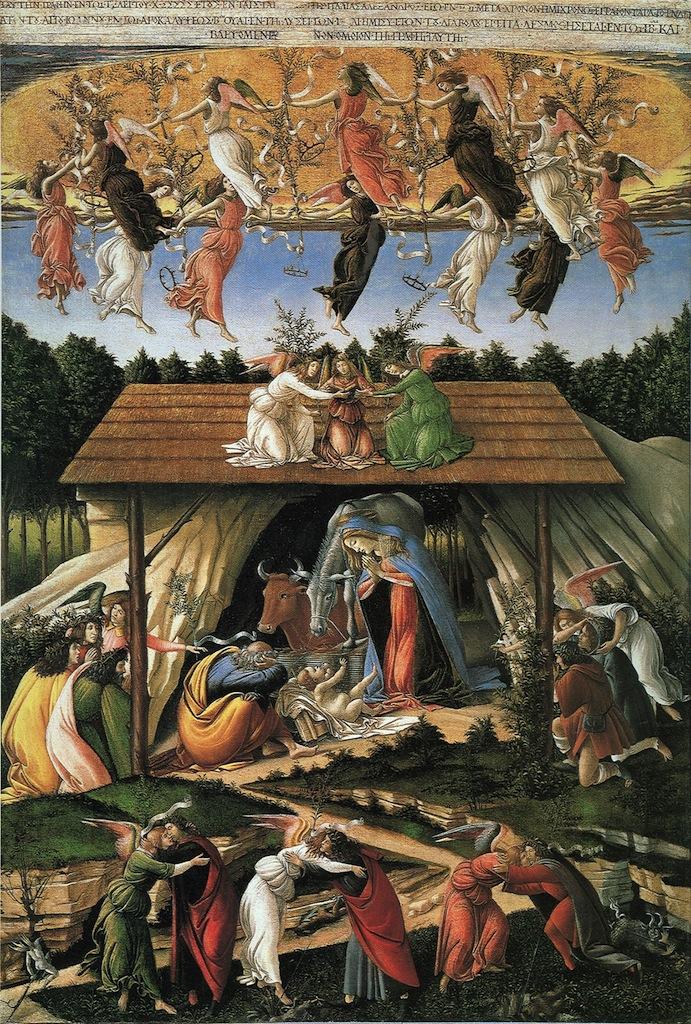I’ve always loved this painting in the National Gallery by Sandro Botticelli. The jewel-like colours and exquisite clarity of detail create a consoling sense of lucidity, as though everything has been revealed to be alright.
The reason for this optimism is, of course, the birth of Christ. Framed in the triangular entrance to a cave with a thatched portico, an extremely tall Madonna kneels at the feet of a similarly large infant (their size indicates their status). Mother and child, the sleeping Joseph and the ox and ass form the still centre of a dynamic composition filled with angels dressed in white, green (some discoloured) and red to symbolise faith, hope and charity.
The three kings may have given up their crowns in compliance with this austerity drive
Twelve angels dancing in a circle beneath the golden bowl of heaven add a mood of festive gaiety. They hold ribbons and olive branches from which dangle three crowns surrendered, perhaps, by the three kings who kneel below, crowned in olive wreaths. Also worshipping the infant are three shepherds placed on the right to enhance the symmetry of the scene.
So far the picture is a traditional nativity, but at the bottom something unexpected is going on. Three angels seem to be saving three men from a clutch of devils who scamper off defeated. The scene, which echoes The Last Judgment, appears to anticipate Christ’s second coming and the end of the world.
Was Botticelli gripped by apocalyptic forebodings like those who expected the world to end when the Mayan calendar ran out on 21 December? If so, he was not alone. The Dominican monk, Girolamo Savonarola, had been instilling fear with fire and brimstone sermons foretelling “a great scourge” and encouraging gangs of youths to roam the streets of Florence confiscating the decadent trappings of wealth. In 1497 he organized The Bonfire of the Vanities, a conflagration of luxurious finery and non-religious books and paintings. The three kings in the Mystic Nativity may have given up their crowns in compliance with this austerity drive.
There is little doubt that Botticelli was influenced by Savonarola. The Greek inscription along the top of the painting refers to the Book of Revelation and “the second woe of the Apocalypse”, which the friar used to cite in warning of things to come, while infra-red analysis of the angels’ ribbons reveals exact quotations from one of Savonarola’s sermons.
By the time this picture was painted in 1500, though, the monk had confessed to being a false prophet, and had been publicly hanged and burned with two of his accomplices. Could they be the three men being saved by angels at the bottom of the picture?
A painting that, at first sight, appears to be a straightforward scene of celebration turns out to contain subversive messages broadcast by a heretic. No wonder Botticelli chose to paint it on canvas instead of wood panelling and to keep it fairly small; that way it could be rolled up and hidden from prying eyes – so enabling it to survive for another 600 years.









![SEX MONEY RACE RELIGION [2016] by Gilbert and George. Installation shot of Gilbert & George 21ST CENTURY PICTURES Hayward Gallery](/sites/default/files/styles/thumbnail_125_x_125_/public/mastimages/Gilbert%20%26%20George_%2021ST%20CENTURY%20PICTURES.%20SEX%20MONEY%20RACE%20RELIGION%20%5B2016%5D.%20Photo_%20Mark%20Blower.%20Courtesy%20of%20the%20Gilbert%20%26%20George%20and%20the%20Hayward%20Gallery._0.jpg?itok=3oW-Y84i)





Add comment